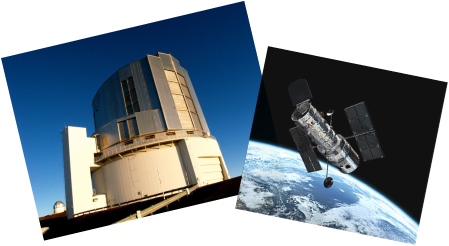
My research is mainly focusing on studying galaxies in the early universe. Using world-class, state-of-the-art telescope such as Subaru or Hubble space telescopes, I have been trying to reveal the physics behind galaxy formation and how they evolve to become those we see in the sky every nights.
Seeking for the origin of Hubble sequence
Do disk galaxies we see today already in place atz~2? (Yuma et al. 2011 & 2012)

Kinematic studies reveal that star-forming galaxies at z~2 show the same rotation property as disk galaxies seen in the present-day universe, suggesting that disk galaxies may already exist at z~2. I perform morphological studies of star-forming galaxies at z~2 with high-resolution Hubble images in order to examine whether or not they are indeed the same as the present-day disk galaxies. Intrinsic axial ratio of star-forming galaxies at z~2 peaks at B/A =0.7, whereas it is B/A =0.95 for the present-day disk galaxies (left figure). My studies clearly show that the star-forming galaxies at z~2 statistically do NOT have the same morphology as the present-day disk galaxies.
Despite some similar properties, the same disk galaxy as we see in the present-day universe is not established yet at z~2.
Despite some similar properties, the same disk galaxy as we see in the present-day universe is not established yet at z~2.
The same stellar populations of star-forming galaxies at high redshifts (z~5)
(Yuma et al. 2010)

Comparison of stellar properties between LAEs (red) and LBGs (black)
At higher redshift (z > 5), there are two major populations of galaxies: Lyman alpha emitters (LAEs) with strong Lya emission and Lyman break galaxies (LBGs) with strong UV continuum. Since the relationship between these two galaxy populations is not well understood, I investigate stellar populations of LAEs at z~5 identified with Subaru images, and find that average stellar masses (10^9 Msun) and ages (25Myr) of the LAEs at z~5 are in the same ranges as those of the LBGs down to the same UV luminosity (right figure). Thus I discover that LAEs and LBGs are basically similar star-forming galaxies; no prominent difference of the stellar properties can be seen between the LAEs and the LBGs.
Strong Lyα emission from LAEs may occur by chance in the duty cycle that
the galaxy manages to have proper mechanisms for emitting Lyα photons out to the observers.
Strong Lyα emission from LAEs may occur by chance in the duty cycle that
the galaxy manages to have proper mechanisms for emitting Lyα photons out to the observers.